At a glance
Expert’s Rating
Pros
Solid antivirus protectionComprehensive protection against online threats
Cons
Notable performance impact on some PCsUser interface is a little scatteredMany of the tools and services feel a bit underbakedPassword manager is difficult to use
Our Verdict
McAfee+ Ultimate offers strong antivirus protection and a vast array of online protections, but its apps, services, and tools could use more polish. Its scans also can tangibly decrease performance on mid-range and budget PCs. As attractive as this comprehensive all-in-one package is, it’s currently a hard sell.
Among the top-tier antivirus software plans, McAfee’s version is an especially loaded offering—and less common in how it bundles together an extraordinary number of online protections.
Many rivals have a premium antivirus suite, then offer services like a VPN, password manager, and identity protection and recovery as separate subscriptions. McAfee instead stuffs everything into one package. This simplifies how much you have to think about, of course, but there’s just one problem—this security suite lacks the polish you’d expect of such a premium product.
Further reading: See our roundup of the best antivirus software for Windows PCs to learn about competing products.
What does McAfee+ Ultimate include?
The full list of features in McAfee’s flagship subscription is exhaustive. Antivirus, link screening, and firewall protection are just the start. You get other major online protections as well—password manager, VPN, web link screening, identity monitoring on the dark web, tracker removal, and if you’re signed up for a family plan, parental controls.
McAfee next throws in its Social Privacy Manager, which offers privacy settings suggestions for social media services; Scam Protection, an AI-powered tool to help screen for risky links in text messages; Online Account Cleanup, which helps you find and delete unused accounts; Personal Data Cleanup, which scans data broker sites and helps you remove yourself from them; and live assistance in setting up your plan’s privacy and identity protections.
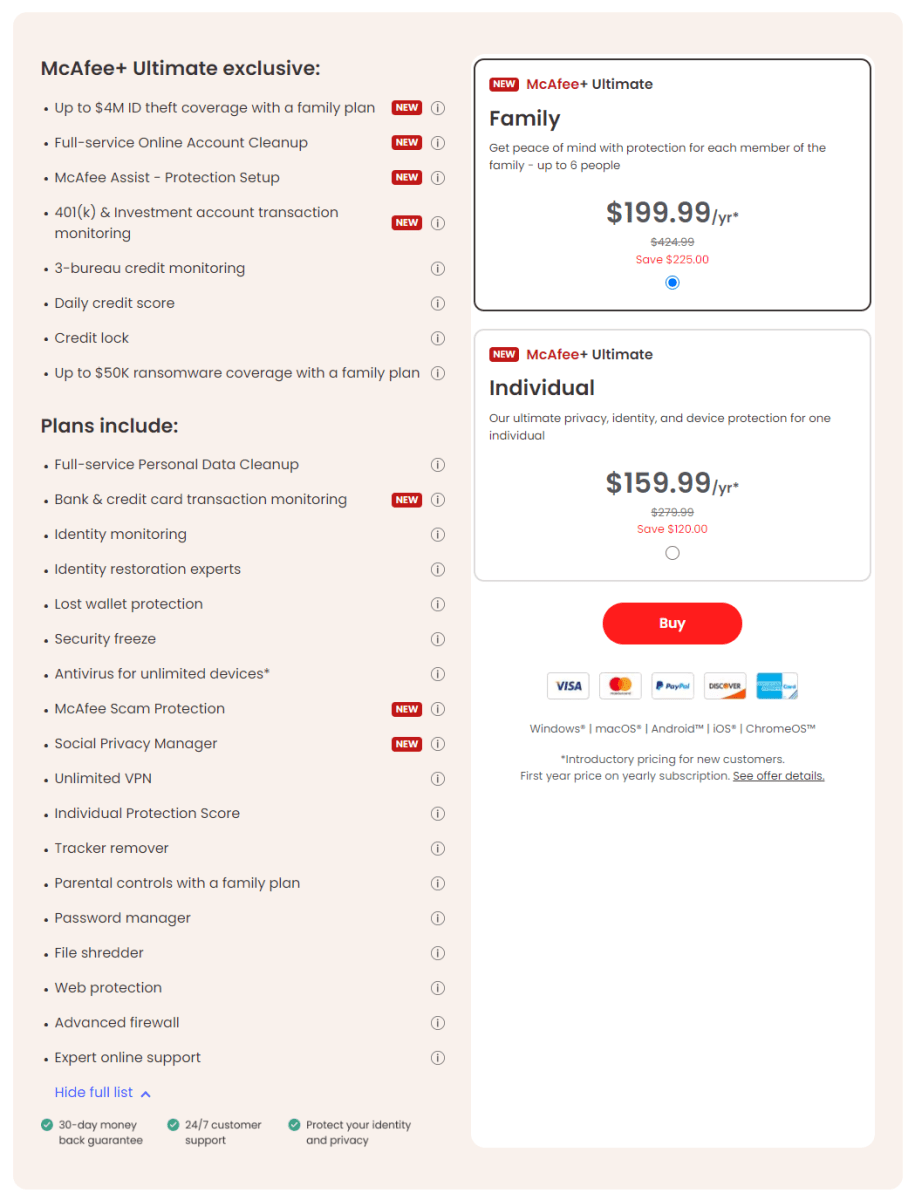 McAfee+ Ultimate’s list of online protections is exhaustive.
McAfee+ Ultimate’s list of online protections is exhaustive.
Finally, on top of all that are financial protections. McAfee+ Ultimate will keep tabs on your bank and credit card transactions, investment and loan account activity, potential bank takeovers, possible payday loans taken in your name, and your credit reports and score. It also offers a centralized interface for locking your credit and placing security freezes on credit, banking, and utilities. And the company provides direct assistance with identity theft restoration, as well as up to $25,000 of coverage for losses related to ransomware and up to $2 million related to identity theft losses and restoration efforts. McAfee even helps with replacing identification, credit, and debit cards for a lost wallet.
Family plans allow you to share these benefits among a maximum of six people—two adult accounts and four child accounts. Each adult account gets its own loss coverage, for a total of $50K ransomware and $4 million for identity theft.) And only adult accounts have access to the data broker and financial protections.
How much does McAfee+ Ultimate cost?
When you buy McAfee+ Ultimate through the McAfee website, an individual subscription is $200 for the first year, then goes up to a full price of $280 afterward. A family plan costs $250 for the first year, and then reverts to $425 per year thereafter. Plans come with a 30-day money back guarantee. Be aware that McAfee enrolls users into auto-renewal by default—and charges for the next year a whole 30 days before your current subscription ends.
McAfee+ Ultimate (Unlimited devices)
$200 for the first year (Individual plan)
$280 per year thereafter (Individual plan)
$250 for the first year (Family plan)
$425 per year thereafter (Family plan)
All McAfee+ Ultimate plans let you protect an unlimited number of devices, with software support for Windows, Windows for Arm, macOS, ChromeOS, iOS, and Android. (Not all features are multiplatform, however.) Family subscriptions offer up to six seats, split between two adult and four child accounts.
Unfortunately, you can’t bring down the cost of a McAfee+ Ultimate plan further by purchasing it from an online retailer. You can only get it through McAfee.
Key features of McAfee+ Ultimate
Installation and user interface
The McAfee app has a clean and modern look, but it feels oddly disorganized despite its simple aesthetic. On the home screen, you get just four shortcuts to main features—antivirus, VPN, Tracker Remover, and Personal Data Cleanup. A fifth helps you add McAfee to more devices, and the sixth leads off to McAfee’s protection score, which rates how completely you’ve set up your plan’s protections.
 The main menu for accessing most of McAfee+ Ultimate’s features.
The main menu for accessing most of McAfee+ Ultimate’s features.
To access all of McAfee’s major features, you must use the left navigation bar. Clicking on the icon with four squares opens a slide-out menu with scanning and web protection options; access to the VPN; firewall info; shortcuts to tools; and links to identity and privacy monitoring, as well as the password manager.
The bottom-most icon in the left navigation bar leads to subscription info, general settings, app updates, help, and privacy and legal terms. These are very simple, and there’s not much you can configure.
Frustratingly, the most premium parts of the McAfee+ Ultimate subscription are nowhere to be found within the app. Instead, you must to head to the McAfee Protection Center portal site (protection.mcafee.com). There you’ll find the links to financial transaction and credit monitoring, parental controls (if you have a family plan), and the Social Privacy Manager browser extension.
 The McAfee Protection Center website.
The McAfee Protection Center website.
Until you’ve poked around thoroughly, remembering if a feature is located in the McAfee app, a separate app, one of three McAfee websites, or a web browser extension can take a while. The apps and the websites don’t always behave quite as expected, either. When I set up Identity Monitoring, adding a second email address triggered new findings (alas), but those results wouldn’t show until I’d refreshed the website. Nothing was wrong, per se, but the experience lacked the kind of polish I expected from an expensive, top-tier security suite.
Unfortunately, this vibe extends through much of McAfee+ Ultimate’s features—not just the methods that you access them through.
Virus, malware, and threat protection
Real-time protection
As you use your computer, McAfee+ Ultimate continually evaluates the files you open and also monitors apps for unusual behavior. While the program does a good job on this front (it earns high marks in independent testing—more info on that below), you’re largely removed from the process, as you never get to see behind the curtain.
Unlike with major rivals, you can’t do things like specifically select folders to protect from ransomware, change settings related to email attachment and script scanning, choose which apps have access to your webcam, or see how external drives are handled. The interface is so simplified that you only have the choice of leaving real-time scanning on, or turning it off. (Presumably only for troubleshooting purposes—otherwise, you lose much of the software’s point.)
For protection while surfing the web, you must install the McAfee WebAdvisor browser extension, which scans for dangerous links and content as you browse online. It gives search engine results safety ratings, warns you about clicking on a possible bad site, and blocks malicious content on compromised but legitimate sites. It works well enough, but oddly, Bing is not on the list of supported search engines. (Sorry, Bing fans.)
 The McAfee WebAdvisor extension in action—those green checkmarks are its safety ratings.
The McAfee WebAdvisor extension in action—those green checkmarks are its safety ratings.
Scheduled and manual scans
By default, McAfee+ Ultimate scans your system once a month, during the wee hours of the morning. You can change the day to another of the three presets, or create your own custom schedule that runs weekly, every other week, or the first week of the month.
If you want to run a manual scan, you get just two options: Quick and Full. Quick focuses just on PC locations typically targeted by threats, while Full examines all the drives and folders on the PC (except for network drives). You can also scan individual files and folders by right-clicking on them and choosing Scan in the context menu that appears.
Firewall
Rather than replace Windows’ built-in firewall, the Advanced Firewall feature works alongside it. It lets Windows screen incoming connections, while McAfee evaluates outgoing connections. If an app tries to connect to what McAfee believes is a bad site, it’ll put it on the block list—at which point you can leave it there, or choose to allow the connection.
Scam Protection
McAfee recently launched a new AI-based tool to help screen text messages for fraudulent links. For it to work, you have to install the McAfee Security & Wi-Fi Privacy app (iOS) or the McAfee Security: VPN Antivirus app (Android). Afterward, it runs in the background, screening messages. To see any that are flagged as dangerous, you’ll have to go to your filtered messages for iOS. On Android, you can see reports about questionable text messages within McAfee’s app.
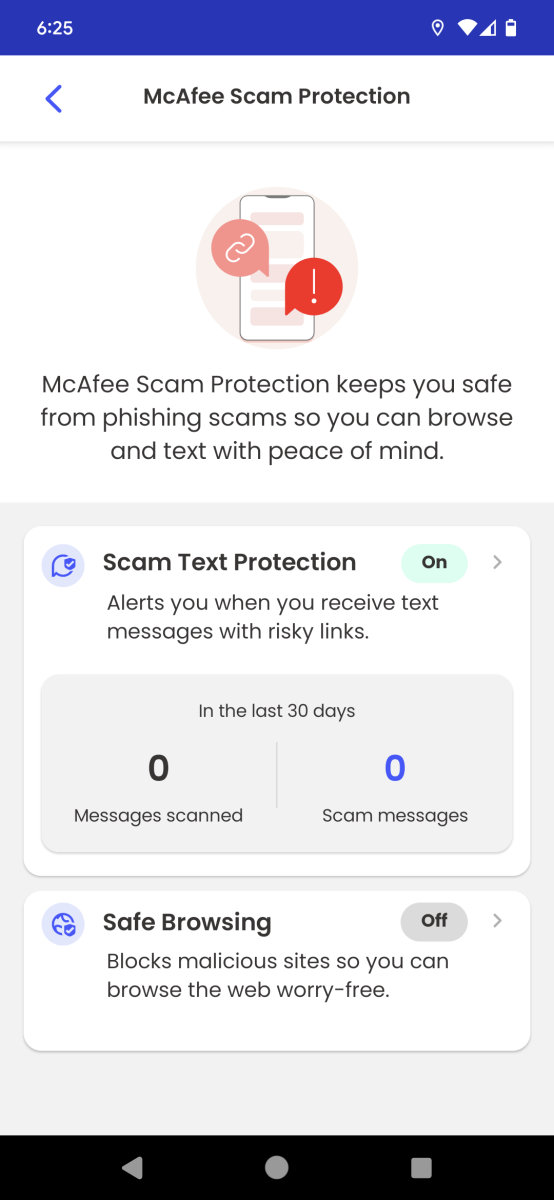 Scam Text Protection in the Android app.
Scam Text Protection in the Android app.
VPN
On PC, you can access McAfee’s VPN in two ways—through the McAfee app, or by separately downloading and installing McAfee Safe Connect. The main difference between them is their interfaces.
In the McAfee app, the controls are consolidated onto one screen. You can turn the VPN on or off, select or change your location, choose auto-connect settings, and turn on the safe reconnect feature (aka kill switch—it automatically shuts off the internet if your VPN connection is disrupted).
If you instead use the McAfee Safe Connect app, it separates VPN use from the settings, putting them on different screens. You can view usage stats and help files related to Safe Connect as well. The Safe Connect VPN works on PC, Chromebooks, and smartphones, with a limit of five devices connected simultaneously.
When using the Safe Connect app, I ran into some bugs. After I installed it and connected to a server for the first time, I couldn’t disconnect afterward—it was only fixed after a reboot. Safe Connect also behaved erratically if I tried starting it before my Wi-Fi finished connecting. A pop-up notification appeared saying I had to upgrade, and then wouldn’t clear. I had to force-quit the program and restart to resolve the issue.
 The VPN interface within the McAfee app is cleaner and more modern.
The VPN interface within the McAfee app is cleaner and more modern.
This VPN offers servers in 47 countries, which span Argentina, Australia, Austria, Belgium, Brazil, Bulgaria, Canada, Colombia, Cyprus, Czech Republic, Denmark, Finland, France, Germany, Greece, Hungary, Indonesia, Ireland, Italy, Japan, Kenya, Latvia, Lithuania, Malaysia, Mexico, Moldova, Netherlands, New Zealand, Nigeria, Norway, Peru, Philippines, Poland, Portugal, Romania, Serbia, Singapore, Slovenia, South Africa, South Korea, Spain, Sweden, Switzerland, Taiwan, United Arab Emirates, United Kingdom, and the United States.
Password Manager
McAfee’s password manager, True Key, covers the basics and not much more. Presumably, the company kept things simple on purpose, but it’s at the expense of better security. For example, your two-factor authentication methods are limited—there’s no way to use OTP software codes, much less a hardware key.
More damningly, True Key’s login protections are flawed. New devices require verification through an emailed link before you can log in. However, McAfee doesn’t always send that email before the login request expires, which happens after about a minute. Sometimes the email wouldn’t hit my inbox until ten minutes after the login attempt. I almost gave up at one point, and then the system worked for a brief moment and I managed to successfully complete the process. This isn’t a new issue, either—look at McAfee’s forums and you’ll see complaints about this dating back years.
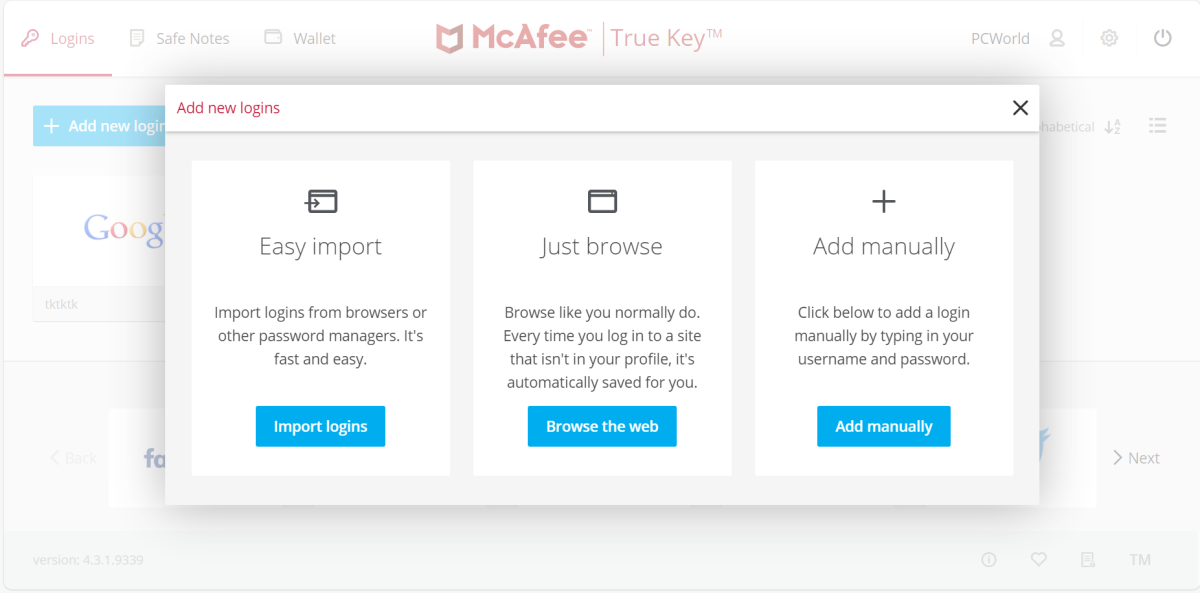 McAfee True Key is a simple, basic password manager, but its weaknesses make it feel unreliable.
McAfee True Key is a simple, basic password manager, but its weaknesses make it feel unreliable.
You’re also only able to use True Key through a web browser extension or a mobile app (iOS and Android). If you’re ever in a position where you can only log into a website for access, you’re out of luck. Plus, when you first setup the service, you have to manually enter an activation code—and if you can’t find the email with that information, you’ll have to dig into McAfee’s account portal (head to Downloads & devices) or McAfee’s Protection Center (My protection) to find it.
All this to say, True Key doesn’t feel like a reliable feature. You’re better off using a standalone service—even a good free password manager outperforms McAfee’s offering by a lot.
Parental controls
Parental controls are managed through a separate piece of software called Safe Family. You install it on the device(s) used by the child, but also on a device managed by the guardian—no web interface exists for monitoring your kid’s usage.
Each child gets their own profile, so you can tailor your restrictions based on age and needs. Safe Family automatically applies default rules based on the stated age of the kid—for example, the app automatically blocked my (imaginary) 13-year old from viewing dating, gambling, and sexually explicit sites, but let them use search engines and view streaming, entertainment, and shopping sites. You can further refine (or overhaul) the default settings, though.
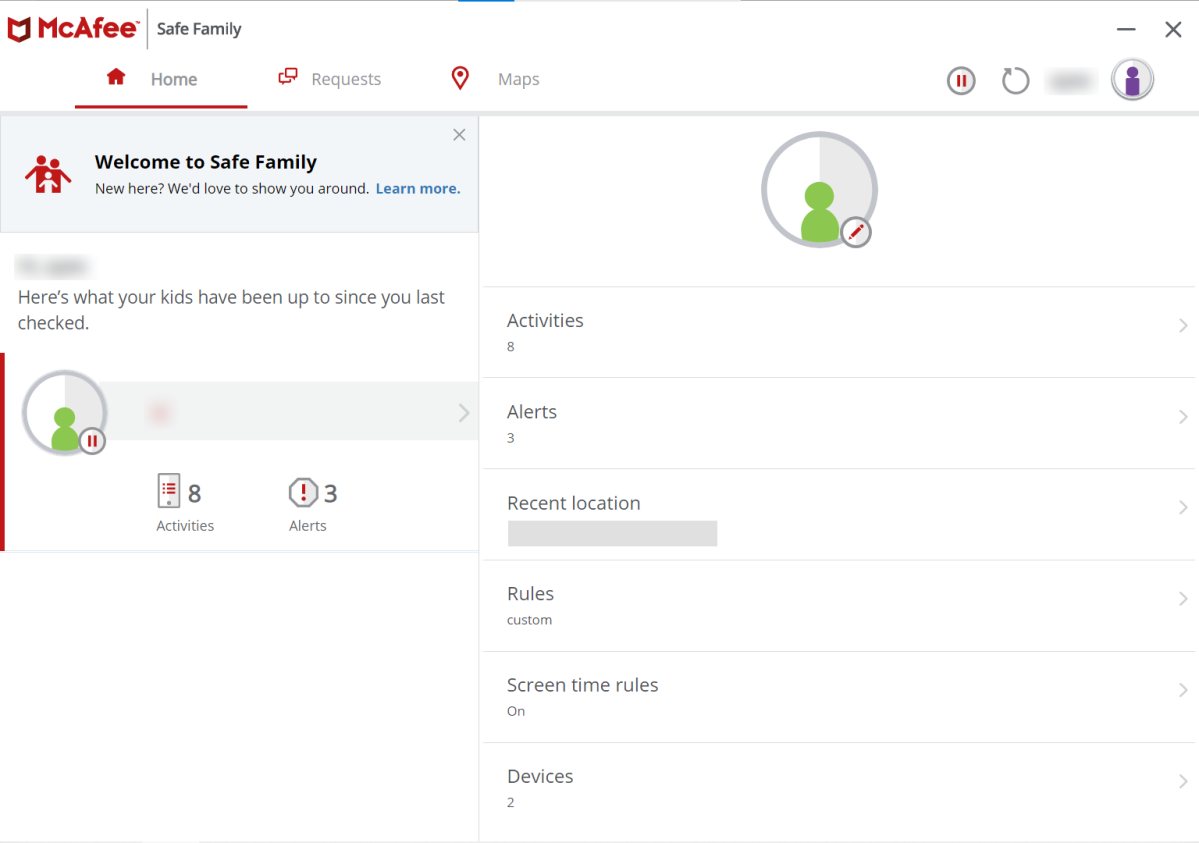 McAfee’s parental controls may look a bit outdated, but they’re easy enough to navigate.
McAfee’s parental controls may look a bit outdated, but they’re easy enough to navigate.
App rules can be created as well, which let you allow or block specific apps on Windows, Android, and iOS. (These are the only devices compatible with Safe Family.) Screen time limits can also be put in place, though you only get two different rules. One’s meant for the weekdays and the other for the weekends, but you can adjust as you see fit.
You can track device location for phones as well, including visits to known places (as set in the app), though I had trouble getting it to work consistently on Android.
Identity and financial protections
McAfee+ Ultimate’s premium features—that is, the reason you pay so much more for this plan compared to the others below it—lie in its identity and financial protections, and they cover quite a bit of ground.
Identity Monitoring scans data from breaches and leaks for your personal information. You have to provide your details to McAfee, which allows you to add credit cards, bank accounts, email addresses, usernames, and phone numbers (up to 10 each); tax IDs, passports, driver’s licenses, and health IDs (up to two each); and your social security number (SSN) and date of birth. The results aren’t always as helpful as they could be; for one email address, several of the listed breaches didn’t give the name of the breach or circumstances, making it harder to know what specific follow-up steps to take. McAfee only gives general advice on how to protect yourself, which is helpful for security newbies but less so for more seasoned internet users.
Personal Data Cleanup helps you find which data brokers have you in their system, and assists with removing you from those sites. Data brokers comb public records and other databases to collect info like your name, current and past addresses, birthdate, phone number, and the names of your relatives. In order for the scan to work, you’ll have to provide your name, birthdate, and full physical address. (You can also optionally add an email address and up to three phone numbers.) McAfee will send removal requests on your behalf, too, but the results can take anywhere from 30 to 45 days. However, for some data brokers, you may have to still follow up on your own.
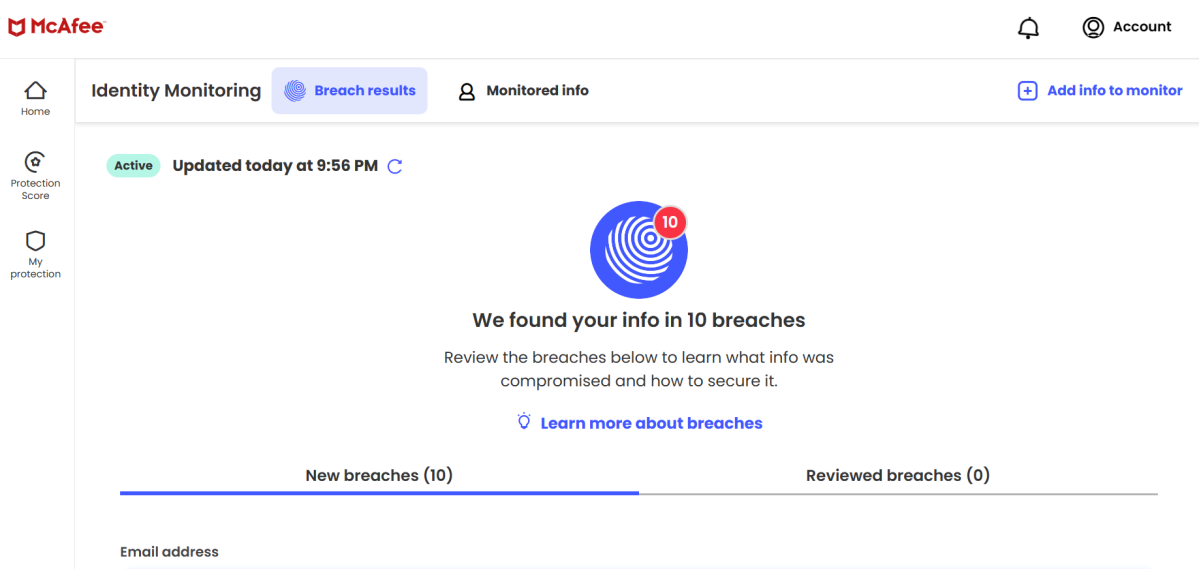 McAfee’s identity monitoring helps keep track of your leaked personal data on the web.
McAfee’s identity monitoring helps keep track of your leaked personal data on the web.
Investment, 401(K), bank, and credit card transaction tracking is done through Envestnet Yodlee, which handles this monitoring for McAfee. It centralizes the types of alerts you may already be receiving (provided you set them up) from your financial institutions. You must log into your accounts via McAfee’s Protection Center portal to link them to Yodlee.
Credit monitoring keeps track of changes to your credit reports at the three major bureaus (TransUnion, Experian, and Equifax). McAfee also gives you access to your daily credit score, lets you lock and unlock your credit, and helps set up security freezes for credit, banking, and utilities as desired.
Identity theft coverage includes the previously mentioned $2 million to cover losses and restoration expenses, as well as $25,000 for losses related to ransomware. (Again, the family plan offers this coverage to each adult account, for a total of $4 million identity theft coverage and $50,000 ransomware coverage.) Identity theft assistance includes access to “identity restoration experts,” or agents who help clean up the aftermath of identity theft. (Note: You must grant a limited power of attorney to McAfee in order for agents to act on your behalf and handle the bulk of the work.) McAfee also offers lost wallet protection, where the company helps cancel and replace identification, credit, and debit cards that are lost or stolen with your wallet.
Additional features
Browser extensions
McAfee+ Ultimate isn’t complete if you don’t install its affiliated browser extensions—though arguably, only one of them is vital.
As mentioned above, McAfee WebAdvisor scans for risky links and content while you browse online, though it won’t evaluate Bing search results. You won’t see a safety rating for any of the links, the way you would for a search through Google. (Yahoo and AOL are still supported, though.) You also won’t immediately see them for the Chrome extension—I had to go into the extension’s settings, scroll down to Secure Search, and choose Tell me if a search result is safe in any search engine.
 In Chrome, I had to manually change the extension settings to show the safety ratings for search engine results.
In Chrome, I had to manually change the extension settings to show the safety ratings for search engine results.
Meanwhile, McAfee True Key—the password manager in the security suite—won’t work on PC unless you install the extension. You can’t log via a website, as you might another service. That said, True Key isn’t my pick for a good password manager, as explained above. I recommend going with a different password manager and installing its browser extension instead. (It makes using a password manager less cumbersome.)
For strengthening your online privacy, you can also install McAfee’s Social Privacy Manager extension. It screens the privacy settings for Instagram, Facebook, Youtube, X/Twitter, LinkedIn, and Google accounts, then suggests improvements. McAfee’s findings are pretty decent—but asking the extension to apply the changes doesn’t always work.
File shredder
To prevent someone from recovering a deleted file, McAfee offers a built-in tool called File Shredder, which overwrites the data using the Department of Defense (DoD) standard. You can use the tool to blanket-erase whole batches of files at once (Recycling Bin contents, temporary internet files, or a custom folder of your choosing), or individual files.
However, this tool comes with one big caveat—you should only use it for files and folders stored on a hard-disk drive. This method of secure erasing doesn’t work as well on solid-state drives (SSDs), which are found in most modern laptops and desktops. It can also shorten their lifespans. You’re better off using other methods for securely wiping an SSD.
Online Account Cleanup
Unused online accounts can hold data you might not want to leave on file—like your credit card details or home address. Data breaches are just too common these days, and when they happen, you could end up losing sensitive data. It can be hard to keep track of the riskiest sites to leave unattended, though.
McAfee tries to speed up the process of cleaning up dormant accounts with its Online Account Cleanup tool, which you’ll use through the McAfee Protection Center portal. It scans one email address from Microsoft, Google, or Yahoo for associated online accounts, then flags the ones it thinks are vulnerable. If you no longer need the account, you can have McAfee delete it for you—or at least, try to. I found that, like McAfee’s other privacy tools, Online Account Cleanup is helpful for pointing you in the right direction, but doesn’t always eliminate as much work as it’s supposed to.
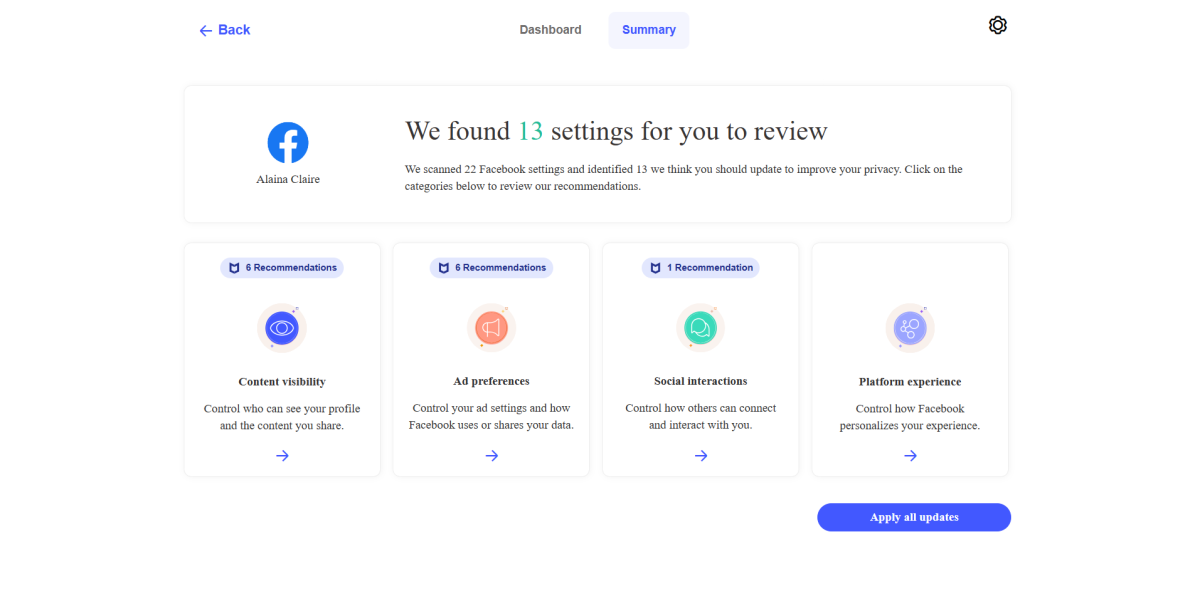 The Social Privacy Manager actually suggests useful changes to privacy settings.
The Social Privacy Manager actually suggests useful changes to privacy settings.
If you need help locking down your social media accounts—that is, keeping your private life out of the hands of advertisers and random snoops—McAfee offers a browser extension that scans five different services (Instagram, Facebook, Youtube, X/Twitter, LinkedIn, and Google), then suggests privacy changes. The proposed changes are generally good, but the issue I ran into was having the extension automatically make them. I also had some problems manually finding the settings in order to do the updates myself.
Customer support
If you need help with McAfee+ Ultimate, you can find it on McAfee’s support website (either through the knowledge database or the virtual assistant), community forums, social media (Facebook, X/Twitter, and YouTube), or by contacting the company though chat or phone. You can reach out to McAfee at any time of day, though the support pages are generally an easy place to start.
However, one problem with McAfee’s support is that their help files can be out of date—some don’t accurately reflect how the interface looks and behaves now, making it harder to figure out what’s a currently available feature (and how to access it).
Updates and maintenance
By default, updates run automatically in the background. For best protection, it’s best to leave this setting as-is. However, if for some reason you’re on a limited internet connection, you can also choose to tweak the settings so that updates are downloaded automatically but not installed automatically, or only be notified when updates are available.
You can also perform a manual check for updates by heading to Help and then Update App.
Performance
For online protection, McAfee performs very well in tests performed by leading security research institutes. In AV-Test’s zero-day attack and malware tests for September and October 2023 (the most current as of this article’s publishing), McAfee’s engine caught 100 percent of the threats.
In AV-Comparatives’ real-world protection test for July through October 2023, McAfee detected 99.6 percent of the 512 test cases, with six false positives. (A false positive is when the antivirus software blocks a legitimate website or download.) The story is similarly good in AV-Comparatives’ September 2023 malware protection test, with a 99.2 percent online detection rate and a 99.95 percent online protection rate.
 AV-Comparatives’ real-world test results for July through October 2023.
AV-Comparatives’ real-world test results for July through October 2023.
AV-Comparatives
McAfee’s one weakness is its offline detection rate in AV-Comparatives’ malware protection test—it caught threats only 65.2 percent of the time. It also had a higher false positive rate, with 10 false alarms. Put another way, McAfee won’t protect your system well without an active internet connection, and it has a slightly higher chance of mistakenly detecting a threat. For comparison, Microsoft’s Windows Defender (which is free) has an offline detection rate of 77 percent, while the top performers clock in at 98 percent and above.
McAfee did not take part in AV-Comparatives’ November 2023 Advanced Threat Protection Test. It evaluates an antivirus program’s resistance to targeted threats like fileless attacks and malicious scripts.
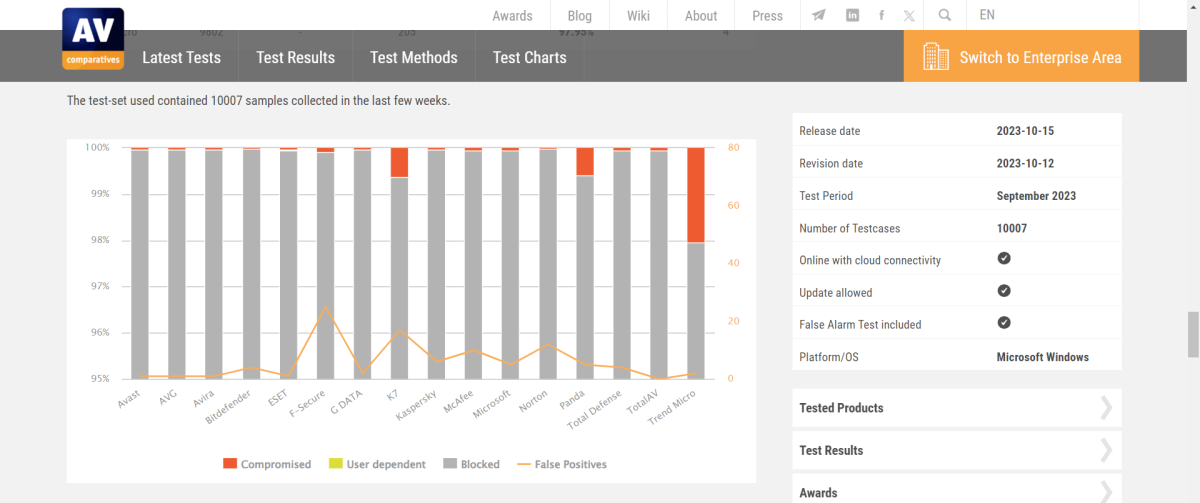 AV-Comparative’ malware test results for September 2023.
AV-Comparative’ malware test results for September 2023.
AV-Comparatives
When running heavy scans, McAfee can notably affect performance on mid-range and budget PCs. Running a continuous full scan during PCMark 10’s benchmark, which simulates web browsing, video chatting, gaming, and editing in open-souce programs like GIMP and LibreOffice for images and documents, dropped the test scores by about 21 percent.
More dramatically, our UL Procyon scores dropped by 41 percent. This particular benchmark simulates using Microsoft Office apps—constantly working in Word, Excel, and PowerPoint, with a fair amount of editing and updating multiple documents. Meanwhile, in Handbrake, the time it took to encode a large video into a smaller 1080p30 file increased by almost 29 percent.
That’s not the whole picture, though. McAfee isn’t a complete killer of performance. When the app was quietly hanging out in the background, watching for threats, benchmark scores in PCMark, Procyon, and Handbrake were virtually the same as before McAfee was installed. And these numbers don’t show how McAfee usually handles full scans. After an initial thorough examination of all files on a PC and any attached external drives, subsequent ones look for new or altered files, which speeds up the scan time considerably. (That then reduces the impact on system resources.)
All this to say, if you don’t transfer or update a ton of files on your system often, you won’t see as much of an effect. But if you do, and you’re running mid-range to budget hardware, then you could feel the impact of a scan while working. McAfee does schedule its full scans for off-hours by default, though.
 This error window popped up randomly and frequently enough to be irritating.
This error window popped up randomly and frequently enough to be irritating.
Instead, I’d say McAfee’s biggest performance issue is a bit different right now—and relates to how it behaves in Windows. After completing my hardware benchmarks, a Windows error notification began to pop up periodically (“mc-wns-client.exe – This application could not be started”) while I evaluated the software features. The steps suggested by McAfee’s help forums—updating the Windows App SDK, uninstalling and reinstalling McAfee+ Ultimate, and manually downloading and installing the latest Windows App Runtime package—did not solve the problem, either.
When I spoke to the company about the issue, McAfee said it was still working with Microsoft, and that a resolution was expected in “early 2024.” That’s a long time to wait for a pretty annoying issue to go away.
How private is my data when using McAfee?
With the amount of sensitive details McAfee asks for—social security number, addresses, birthdate, etc—you might wonder how safe it is to hand over the whole set to one entity. McAfee outlines how it handles your info in its privacy and legal terms, but I also asked the company who specifically sees the data and the protocols used to safeguard it.
McAfee says that it partners with Transunion (one of the three major US credit bureaus) for matters related to identity theft and power of attorney, and Yodlee for transaction monitoring. As for the data itself, McAfee says AES-256 encryption is used, and the engine that monitors for threats keeps only a hash of the values. (That is, it stores the result of encrypting your social security number or full name, etc, rather than the details themselves.) It’s only decrypted when a user views reports related to these sensitive pieces of information. McAfee says those unencrypted, plaintext versions of the data is only ever kept on the backend server, and “never exposed to the front end.”
While this methodology is reasonable enough, you’ll have to decide for yourself how comfortable you are with it—as well as the general principle of having your most sensitive info so centralized.
Conclusion
With more polish, McAfee+ Ultimate would be an ideal security suite for someone who wants an easy-to-understand yet still comprehensive set of online protections. Its interface has a look and feel that’s friendly toward people less familiar with online security; the antivirus protection is solid; and its features span everything you’d want to safeguard. But until its tools and services can nail their promises, and the performance glitches are resolved, McAfee+ Ultimate is a hard sell right now—especially at full price.
Editor’s note: Because online services are often iterative, gaining new features and performance improvements over time, this review is subject to change in order to accurately reflect the current state of the service. Any changes to text or our final review verdict will be noted at the top of this article.
>>> Read full article>>>
Copyright for syndicated content belongs to the linked Source : PCWorld – https://www.pcworld.com/article/2178063/mcafee-ultimate-review-solid-antivirus-protection-tons-of-slightly-disappointing-features.html





























